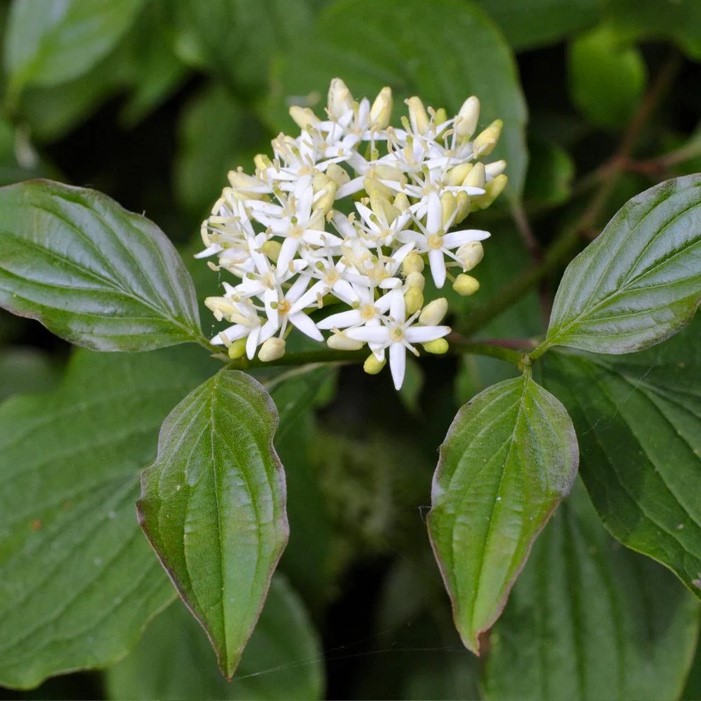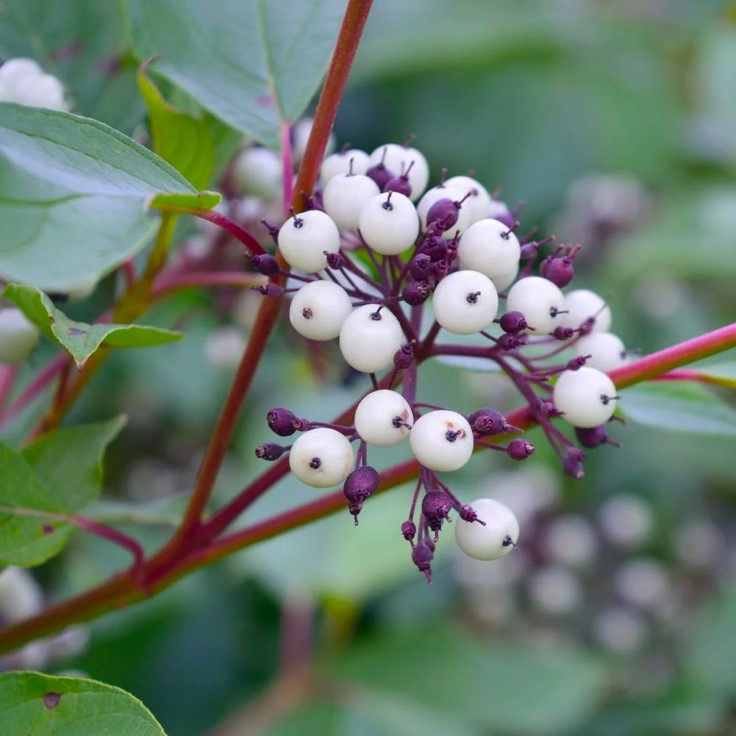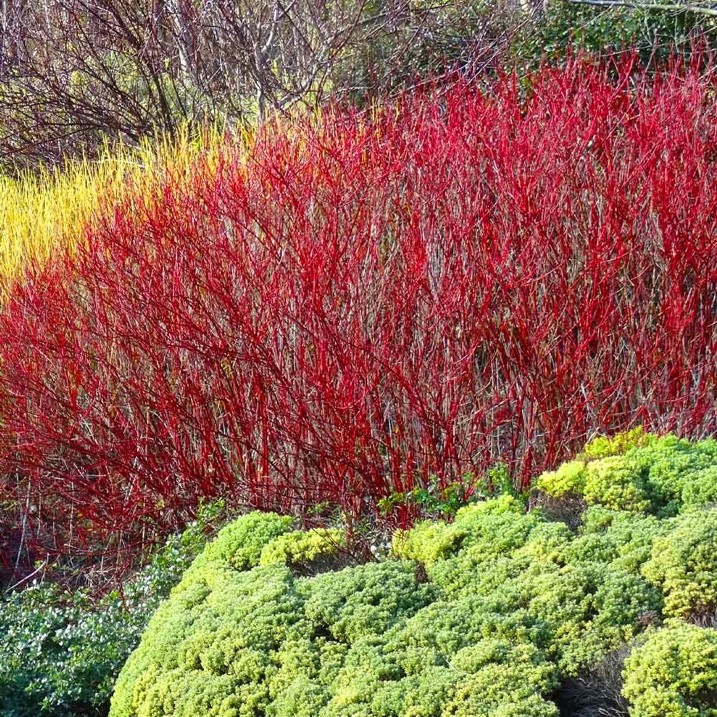Scientific name: Cornus sericea
Common names: red twig dogwood, red osier dogwood, red osier, red brush, red willow, redstem dogwood, red-rood, American dogwood, creek dogwood, western dogwood
Botanical name: Cornus sericea
Family: Cornaceae
Life form: Deciduous shrub
By Claudia Karll
Background on the name: There are three distinct species that are included in the common name of red twig dogwood: Cornus sericea, or red osier dogwood, is native to North America and will be the focus of this article. However, there are two more species which you may come across: Cornus alba, or Tatarian dogwood, which is native to Asia, and Cornus sanguinea, or bloodtwig dogwood, which is native to Europe. With red stems resembling those of some osier willows, the Cornus sericea earned the common name of red osier dogwood. Genus name is derived from the Latin word cornu which means horn, a hard material, referring to its strong, dense wood. Species name means silky, describing the hairs on young twigs and leaves.
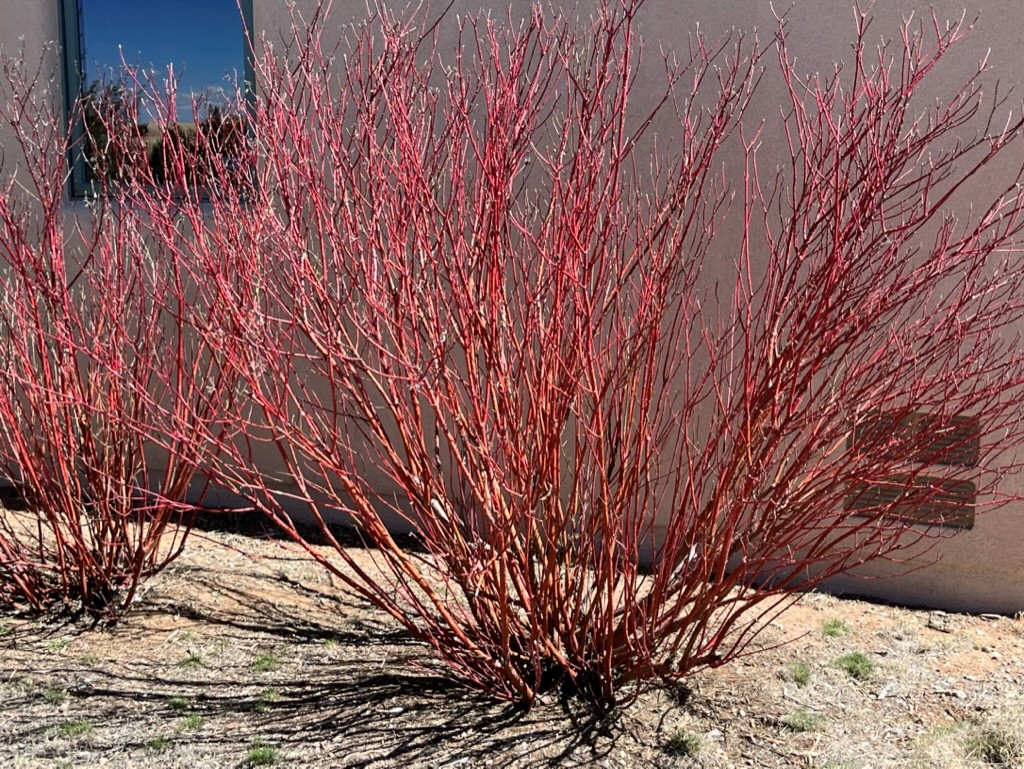
Photo: Claudia Karll
Range of native growth: As stated above, Cornus sericea is native to North America from sea level to 10,000 feet, throughout boreal and temperate zones, from Alaska east to Newfoundland, south to Durango and Nuevo León in the west, and Illinois and Virginia in the east. Because it likes medium to wet soil, native stands are often found growing in swampy areas, edges of wetlands, and along lakes and rivers. Farther from such wet zones, red twig dogwood can also be found in regions that receive more than 20 inches of precipitation annually. It tolerates flooding and has been known to survive up to seven years with its root crown under water. In New Mexico it is almost always found in riparian areas, very rarely far from perennial water.
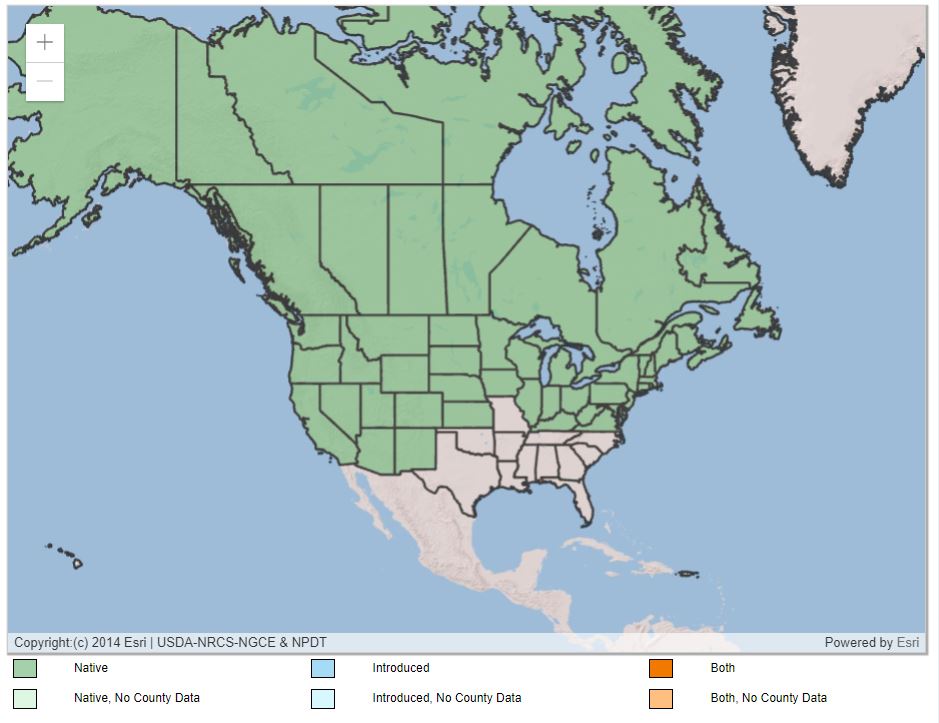
USDA, NRCS. 2023. The PLANTS Database (http://plants.usda.gov, 04/30/2023). National Plant Data Team, Greensboro, NC USA.
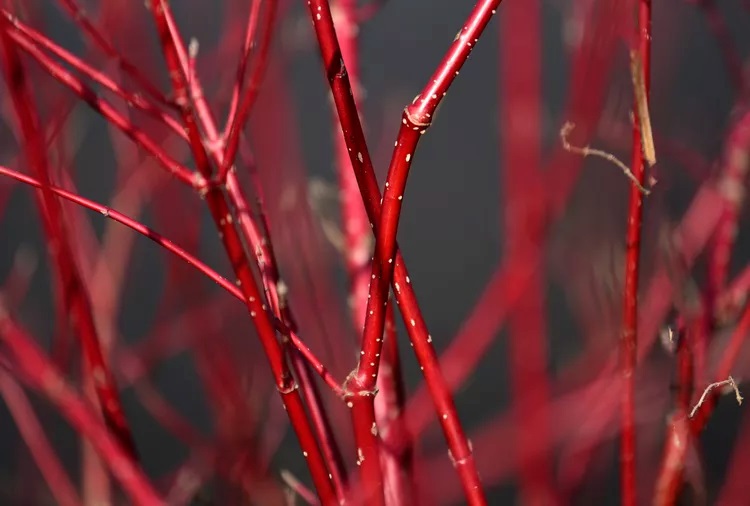
The Spruce / Evgeniya Vlasova
Description of the main morphology: Red osier dogwood is a flowering shrub with four-season interest: white blooms in spring, medium to dark green leaves in summer, berries from summer to fall, and bright red bark in winter after leaves have dropped. It is a medium to tall shrub 6 to 9 feet tall and 7 to 10 feet wide. Its blossoms are tiny, fragrant, white, flat-topped umbels that emerge from May to June and sometimes continue into summer. The flowers yield clusters of whitish berries that may have a bluish tinge. The 2- to 5-inch long oval to lanceolate leaves change from green to red and finally purple in fall. The red stems are less obvious in the wild when growing in the shade. The reddest stems are the new growth.
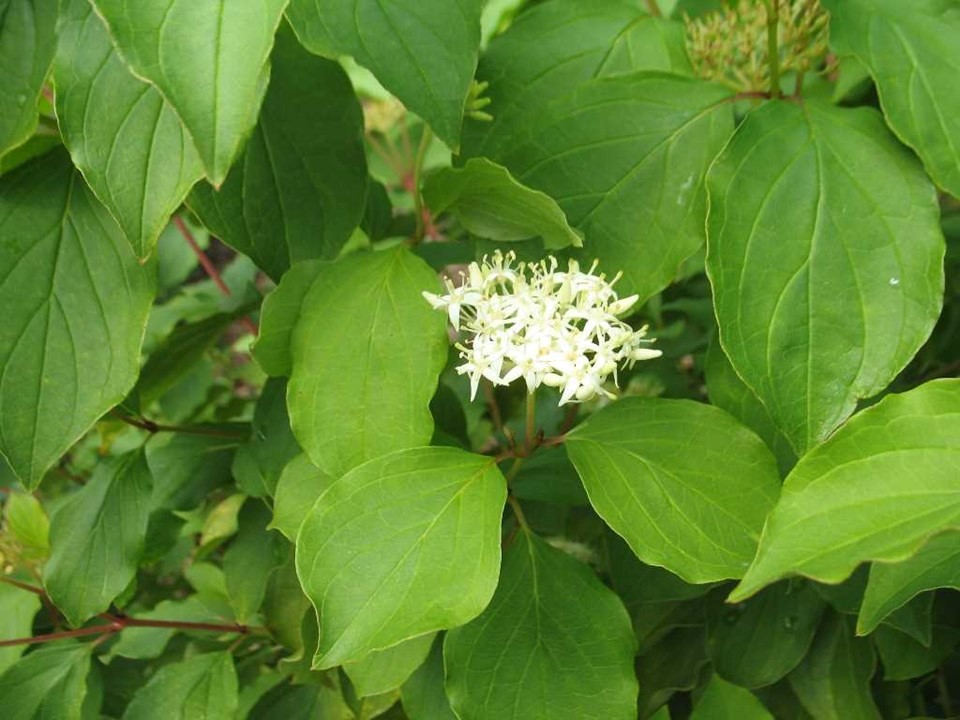
Courtesy Missouri Botanical Garden PlantFinder. https://www.missouribotanicalgarden.org/PlantFinder/PlantFinderDetails.aspx?taxonid=279363#AllImages
Ecology: Red twig dogwood provides food and shelter for mammals and birds. Moose, elk, bighorn sheep, mountain goats, beavers, and rabbits eat the stems and new shoots. The fruit is eaten by bears, small mammals, and many different bird species. The shrub forms thickets suitable for nest building by American goldfinches, robins, brown thrashers, eastern bluebirds, gray catbirds, northern flickers, mockingbirds, and purple finches. It has a spreading habit that allows it to form a colony over time. The roots, especially of the cultivar ‘Cardinal,’ will hold soil and aid with erosion control. After a fire, it will resurface in the affected area by sprouting from seeds or damaged shrubs. Generally speaking, the red twig dogwood is not in need of protection or conservation, except in Iowa where it is considered vulnerable, and in Kentucky and Virginia where it is considered critically imperiled.
Natural history: Native Americans had uses for various parts of the red twig dogwood: to treat colds and slow bleeding by eating the berries (Plateau Indigenous tribes); to make a “traditional tobacco” by using the inner bark alone or mixed with other plants (Lakota tribe and others); to make the smoking mixture called kinnikinnick by adding the inner bark to tobacco (Ojibwe of the Algonquian); to improve the taste of the smoking mixture by adding the inner bark to the bearberry leaf (western tribes); to produce dye by using the inner bark mixed with other plants or minerals (Ojibwe); and finally, to weave baskets using the withies / osiers.
Gardening tips: If you are thinking of adding red twig dogwood to your home landscape, here are additional details to consider.
First, plant in the fall or the early spring, Zones 3 to 7, in organically rich, fertile, moist, slightly acidic soils. This dogwood even tolerates swamp-like or boggy soil conditions. It is shade tolerant but prefers full sun to part shade and will put on a more colorful winter show if exposed to high levels of light. In New Mexico a northern or eastern exposure, or one under overstory trees, will best protect the plants from sunburn and heat stress
Second, because its colony grows by suckers, carefully choose the location where you will plant. Perhaps you are willing to allow spread because you want a hedge or thicket, for example to control erosion. On the other hand, if you want to include red twig dogwood in a shrub border, you will need to trim the roots with a spade and remove root suckers to manage the colonial spread.
Third, the reddest stems are new stems. Many gardeners encourage new growth by pruning up to one third of the old stems in early spring. Other gardeners prefer to prune all stems to a height of 8 inches every 2 to 3 years. Such spring pruning will of course affect the quantity of flowers; but this is not a great concern because the flowers are less important in the overall scheme of year-round interest.
Fourth, the red twigs pair exceptionally well for winter contrast with yellow twig dogwood C. sericea ‘Flaviramea’. It is suitable in a shrub border, combined with evergreens as well as yellow twig dogwood; in naturalistic plantings of very moist soils where it can become a thicket; or as a property line screen. The red twigs are attractively displayed when planted in front of a wall. The leaves can sunburn in New Mexico if they receive too much sun, for instance if planted in front of a reflective south or west wall, and the plant would need more water in such a location.
Fifth, be aware of problems that can affect the red twig dogwood. When plants are stressed in hot and humid summer climates, they become more vulnerable to diseases and fungal problems such as canker, leaf and twig blights, leaf spots, and insect pests such as the dogwood sawfly. Spider mites can be a problem in the high, dry conditions of many New Mexico gardens. If you garden in a riparian site or other conditions with rich soil and water this plant will reward you with year-round beauty.
Sources
Beaulieu, David. “How to Grow and Care for Red Twig Dogwood”. Thespruce.com. 13 September 2021. Web. 28 March 2023. Retrieved from https://www.thespruce.com/red-twig-dogwood-shrubs-2132727
“Cardinal Red-Twig Dogwood”. Monrovia.com. 2023. Web. 29 March 2023. Retrieved from https://www.monrovia.com/cardinal-red-twig-dogwood.html
“Cornus sericea”. Plant Finder. Missouri Botanical Garden. Web. 29 March 2023. Retrieved from https://www.missouribotanicalgarden.org/PlantFinder/PlantFinderDetails.aspx?taxonid=279363#AllImages
“Cornus sericea”. Wikipedia.org. 16 March 2023. Web. 29 March 2023. Retrieved from https://en.wikipedia.org/wiki/Cornus_sericea
“Red Twig Dogwood Shrub”. FastGrowingTrees.com. 2023. Web. 6 April 2023. Retrieved from https://www.fast-growing-trees.com/products/redtwigdogwood?variant=13940771651636&utm_source=google&utm_medium=cpc&utm_campaign=PMax%3A+%28MT%29+-+Smart+Shopping+-+Flowering+Trees&utm_term=&gclid=Cj0KCQjw27mhBhC9ARIsAIFsETGGqP7rVs0WH5-P3YdlMrv7SjS8z8ZKKInuV9Wa_e7QXtMD5ht6VV8aAswNEALw_wcB

